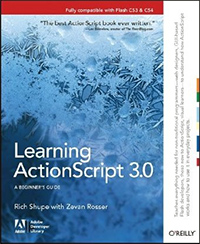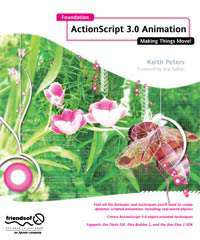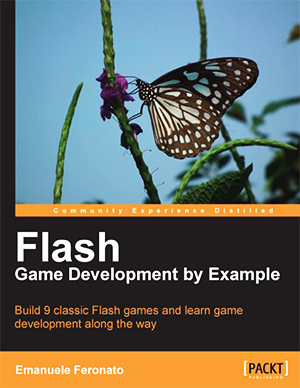Posts Tagged ‘books’
-
Learning ActionScript 3? Here are some great books
31st May 20117After publishing my review of the recent Flash Game Development by Example book (in which my complaints were validated by similar reviews from Iain and Rasmus) I received a number of questions both by email and on Twitter asking me books what I would recommend.
The first thing I’ll say is that I don’t believe there are ANY good books that teach you how to code in AS3 by using game development as the means.
There are some excellent AS3 books, and some excellent game development ones, but all those that have tried to combine the two end up either skipping vital AS3 details, or build such basic games you don’t really learn anything about game development in the process.
Before I begin however this is important: Obviously I have not read every book there is on AS3. So my recommendations here can only be based on the books I have read and value. If you’re the author of a book not listed, that you think should be, send me a review copy. Here’s my list with links to the publishers sites (and no cheesy affiliate links!)
Learning ActionScript 3 by Rich Shupe, O’Reilly
 I strongly suggest the excellent “Learning ActionScript 3.0” by Rich Shupe and Zevan Rosser. Even if you’ve been coding in AS3 for a while there are things this book can teach you. It leaves virtually no stone unturned. Read this from cover to cover and you will have touched on every aspect of AS3 you need. From the way events propagate, to text handling, bitmap filters and display list management it’s comprehensive and clearly written. The only issue is that the contents are a bit dry. By this I mean you’ll never actually create anything fun while reading this, and you won’t learn a thing about game structure. But to sink your teeth into AS3 they don’t come much better than this. The 2nd edition was published at the end of 2010 incorporating Flash platform changes that entails, so if you do seek out a 2nd hand copy, make sure it’s a recent one.
I strongly suggest the excellent “Learning ActionScript 3.0” by Rich Shupe and Zevan Rosser. Even if you’ve been coding in AS3 for a while there are things this book can teach you. It leaves virtually no stone unturned. Read this from cover to cover and you will have touched on every aspect of AS3 you need. From the way events propagate, to text handling, bitmap filters and display list management it’s comprehensive and clearly written. The only issue is that the contents are a bit dry. By this I mean you’ll never actually create anything fun while reading this, and you won’t learn a thing about game structure. But to sink your teeth into AS3 they don’t come much better than this. The 2nd edition was published at the end of 2010 incorporating Flash platform changes that entails, so if you do seek out a 2nd hand copy, make sure it’s a recent one.I used to recommend Essential ActionScript 3 by Colin Moock (also by O’Reilly) but the freshness of content in this book kicks it one level higher.
http://oreilly.com/catalog/0636920010401
ActionScript 3.0 Cookbook, O’Reilly
I’m a big fan of the O’Reilly cookbooks. They come into their own when you’re starting to learn a language and have the basics down – but just need to know in which package to look to find the solution to a given problem. For example if you want to know how to load an XML file you can just pick-up the cookbook and look for that in the index. The code examples are concise and well written, and coming from a variety of authors seems to help make them more relevant. It’s a really vital book. Yes you can Google, but if you are learning a language there is no way for you to evaluate how well written (or correct!) a Googled blog post is for example. The only issue I have with this book is that it hasn’t been updated since 2008. It was however the way I learnt AS3 (used with the Essential AS3 book).
http://oreilly.com/catalog/9780596526955
Foundation ActionScript 3 Animation: Making Things Move! by Keith Peters, Friends of Ed
 This is a brilliant book. There’s no other way to put it. It starts off with a great crash course in AS3 (take note authors, this is the correct way to do it) and then dives in to, well.. making things move! Making them properly move. None of this Flash IDE timeline stuff, but actual real physics that you can use in real games. And it’s not complicated physics either. It starts off very gently and then keeps layering it up. Bouncing, friction, gravity, velocity. Throwing objects with the mouse, collision, springs, the works. There is even a little chapter on faux 3D (which to be honest feels shoe-horned in, and isn’t very relevant today). You will learn both good structured AS3 AND very useful game development techniques from this book, which is why it’s essential reading. The only down side is that it hasn’t been updated for a while. There is a follow-up book (Advanced Animation) but it’s not as easy to get in to and feels a little more “edge case” in its application. Still a fascinating read though.
This is a brilliant book. There’s no other way to put it. It starts off with a great crash course in AS3 (take note authors, this is the correct way to do it) and then dives in to, well.. making things move! Making them properly move. None of this Flash IDE timeline stuff, but actual real physics that you can use in real games. And it’s not complicated physics either. It starts off very gently and then keeps layering it up. Bouncing, friction, gravity, velocity. Throwing objects with the mouse, collision, springs, the works. There is even a little chapter on faux 3D (which to be honest feels shoe-horned in, and isn’t very relevant today). You will learn both good structured AS3 AND very useful game development techniques from this book, which is why it’s essential reading. The only down side is that it hasn’t been updated for a while. There is a follow-up book (Advanced Animation) but it’s not as easy to get in to and feels a little more “edge case” in its application. Still a fascinating read though.http://www.friendsofed.com/book.html?isbn=1590597915
With the above 3 books I honestly believe you can go from knowing nothing at all about AS3, to having touched all the important aspects of it, and even built some really cool things in the process. Use them in combination with a framework like Flixel and suddenly a LOT of the way Flixel does things will make a great deal more sense to you. Equally if you stumble across a piece of source code online you’ll have a much better idea if you’re looking at quality code or a piece of blog filler.
Advanced ActionScript 3 with Design Patterns by Joey Lott, Adobe Press
This was recommend by both Iain Lobb and Damien Altron. Be sure you get the correct book as there is a very similar titled book published by O’Reilly. The one you want is published by Adobe Press. The first half deals with general AS3 practises and the second half the use of design patterns. From the comments I’ve read it appears it’s very well researched and written.
http://www.amazon.co.uk/Advanced-Actionscript-3-Design-Patterns/dp/0321426568
I will follow-up this post with one listing my favourite AS3 Game Development books shortly. But really, get the language down first. Then make games. Not the other way around.
-
Flash Game Development by Example Book Review
25th May 2011 Emanuele Feronato is a familiar name to anyone who’s ever searched for something to do with Flash game development on Google. The tutorials he publishes on his blog are as ubiquitous as the platform itself. They provide nuggets of code usually meaty enough to accomplish the task at hand. Be it creating a Match-3 knock-off, a landscape generator or showcasing a new library. The complexity never really leaves the shallow end of the pool, which I suspect is the main reason beginners flock to his site.
Emanuele Feronato is a familiar name to anyone who’s ever searched for something to do with Flash game development on Google. The tutorials he publishes on his blog are as ubiquitous as the platform itself. They provide nuggets of code usually meaty enough to accomplish the task at hand. Be it creating a Match-3 knock-off, a landscape generator or showcasing a new library. The complexity never really leaves the shallow end of the pool, which I suspect is the main reason beginners flock to his site.But with a book you leave the safety zone of “this is just enough” behind. When people have put down good money, the expectation levels are rightly higher. So it was with intrigue that I started reading Flash Game Development by Example. It covers the creation of 9 games across 300+ pages, which is an average of 30 pages each. Probably 28 more than he uses on his web site 🙂 I was curious what this extra space would provide.
The first game we make is Concentration or “Pairs”, the classic card game. Everything is done in the Flash IDE at a size of 550 x 400, and it leads you step-by-step through creating an FLA, creating your Main.as, entering a trace statement to prove it compiles and then explaining what imports and packages are. The explanation for the Sprite package for example is “This class allows us to display graphics”. That’s true, and while I’m not expecting a detailed explanation at this level I did expect a little more. Emanuele then starts creating the game, kicking off with a loop to make an Array of 20 tiles. Every single line of code is explained – rapidly jumping through AS3 syntax as it goes. It’s as if the single line of source “for (var i:uint=0; i<NUMBER_OF_TILES; i++)” caused Emanuele to stop and realise he had better explain what a uint, a constant and a for loop is before he can carry on.
The problem with this approach is you forget what it was you were building as you try to deal with a rapid onslaught of new information. And it doesn’t let-up. By page 19 the game is dealing with adding a Fisher-Yates shuffle algorithm. A quick trip back to the Flash IDE creates some tiles, and more code starts displaying them and adding event listeners for clicks. By page 31 you’re deep in the realm of indexOf Array checks, event.currentTarget magic value access and modulo operations. Nearly every line of code is still being explained but the pace is borderline frantic. And just like that, it ends. The game is complete, a few homework assignments are given to you and we’re on to Chapter 2.
Chapter 2 is about building Minesweeper. So multi-dimensional arrays and iterative scanning for mines. It also contains probably my favourite quote in the whole book:
“Just think about a function like a mad witch. You give her some strange stuff such as bat wings and lizard tails, and after making something mysterious she gives you a potion to turn someone into a frog. The great thing is once you’ve made your functions (witch) you don’t need to know how they do the magic anymore.”
🙂
However this is a bit of code taken from the function it teaches you to make:
Read More -
Spectrum Games Bible
18th Aug 2009
I was really excited to receive another couple of books in The Spectrum Games Bible series today. It’s a series of 6 books that present screen shots and mini community written reviews of 1,200 Sinclair Spectrum games released between 1982 and now. Editted and compiled by Paul Johns and Michael Fraser these are fascinating reads.
I love just picking a book and opening it on a random page to see what retro gaming delight (or howler!) will greet me. The games are presented by year and alphabetical order, with a neat index at the back of each should you wish to locate something specific.
Game reviews are often quite short, but for some span a page or two. Nearly all of them have screen shots which really help to jog the old grey matter. As the reviews are written by community members they vary in quality. Some are a little too introspective, focusing on the life story behind that particular game for the reviewer, rather than the game itself. But overall they are still a great read. I’d strongly recommend them to anyone who has an interest in retro gaming, or Flash game development today – as they are a gold mine of ideas and concepts.
The books vary in price as they are printed and delivered by lulu.com, so the higher the page count, the more it costs. The print quality is excellent and the colour covers a nice touch. Layout is clean and clear and I had no printing issues with any of them. If you are extremely flush with cash then you can buy full-colour editions, which have all screen shots in full colour internally. The cost of these editions ranges from between £40 and £70, with postage on-top! However the ones I (and I dare-say most people) own are the colour cover with black and white internal pages. They are a far more reasonable £9 to £10.
Visit the web site for more details: http://www.spectrumgamesbible.co.uk
Hire Us
All about Photon Storm and our
HTML5 game development services
Recent Posts
OurGames
Filter our Content
- ActionScript3
- Art
- Cool Links
- Demoscene
- Flash Game Dev Tips
- Game Development
- Gaming
- Geek Shopping
- HTML5
- In the Media
- Phaser
- Phaser 3
- Projects
Brain Food




